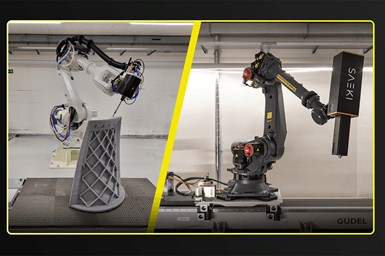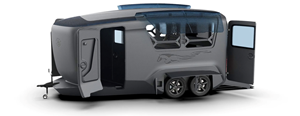Saeki Robots Manufacture Large Parts for Lights-Out Production
Saeki says it is building flexible factories of the future by leveraging digital manufacturing and robotics, providing an end-to-end automation solution in 24 hours with manufacturing large parts performed by robots.
Share
Robotic digital manufacturing includes 3D printing, machining, postprocessing and part inspection with one robot, fully automated. Photo Credit: Saeki
Saeki is offering robots-as-a-service for the manufacturing industry, enabling flexible lights-out factories of the future by leveraging digital manufacturing and robotics. The company provides end-to-end automation for 3D printing, machining and inspecting functional large parts, delivered next day.
It is said the architecture, engineering and construction industry has undergone significant changes in recent years, yet one major challenge they face is the slow and costly manufacture of large components as part of their installations. Enabling the industry to move faster and efficiently, Saeki has launched from stealth with a $2.3 million seed funding round to create fully automated plants with industrial robots using 3D technology to create anything from wings for aircraft to construction site installations.
Founded in 2021 by Andrea Perissinotto, Oliver Harley and Matthias Leschok, Saeki works with the architectural design, engineering design and construction services industry to turn complex designs into reality. In the process, Saeki helps customers save concrete and CO2, due to its method for cost-effectively producing custom concrete formwork. The company achieves this by combining 3D printing and milling with large industrial robots that can print formwork up to many meters in length, very efficiently and when it comes to design complexity, the opportunity is unlimited.
Time Savings
Currently, to develop a lightweight carbon fiber element, or to build a topologically optimized concrete floor slab, buyers would have to wait months and spend vast sums of money to receive a first sample and only then build a prototype, let alone consider reiterating for any flaws. With Saeki, this bottleneck is removed, enabling buyers to rapidly innovate and grow their services and offerings in ways they have not been able to before. Indeed, for large-scale items, this has not been previously possible.
“From what we build underground, to what we build on earth, to what goes to space, from the construction to aerospace industries, there is a need for large, one-off (custom) components, that are mostly used once, a couple of times at most, then scrapped,” says Andrea Perissinotto, Saeki co-founder. “Manufacturing these parts — from the molds to make concrete elements to the tooling required to build composite rockets — is labor intensive, has long lead times and is very expensive. Moreover, these factors delay hardware iteration to get to the final product.”
How It Works
For vast swathes of industry, Saeki says it’s not practical to own and manage robots that can create what manufacturers need quickly. With Saeki’s approach, customers become the virtual owner of a robot at a Saeki factory with a customized robotic manufacturing cell and guaranteed uptime.
“We are at the forefront of addressing this and democratizing access to the best tools and creating productive, sustainable and effective outcomes for industry,” Perissinotto says. “Long lead times for large components will be a thing of the past and we can provide faster and cost-effective iterations. Our comprehensive approach sets us apart. It's not just about being faster or cheaper. It’s about providing a complete solution that caters to the entire spectrum of challenges, which is resonating well with our customers.”
Saeki says it is focused on building a partnership of trust, support and mutual growth with its customers. The team currently works hand-in-hand with customers, understanding their unique challenges, and tailoring the microfactories to address their specific needs.
Production Hubs
Saeki is building its first production hub, which will be the blueprint for further expansion. In an industry bottlenecked by manual processes, the company takes on the difficult challenge of solving manufacturing problems, acting as a catalyst and enabler for radical growth and progress across industry.
The production hub will offer industrial robots built by Saeki. The robots will combine multiple digital manufacturing methods, from 3D printing, milling and inspection to creating an all-in-one low waste production process and recyclable materials. The robots will act as microfactories — self-contained units able to do all the manufacturing steps, and easily deployable for localized manufacturing. Additionally, Saeki will offer a quoting platform tailored to the customers' own business needs.
Saeki is building a platform that will enable customers to transcend the limits of traditional manufacturing, where size, complexity and efficiency are no longer obstacles but catalysts for progress. In doing so, Saeki envisions a network of decentralized, robot-operated production hubs around the world.
“In 10 years from now, Saeki envisions lights-out factories filled with Saeki microfactories autonomously producing complex, material- and weight-saving formwork for the construction industry; fixtures and tooling for supersonic jets; or composite molds for the next-generation Formula One cars,” says Matthias Leschok, Saeki co-founder. “Saeki’s mission is to empower design freedom to be efficient and sustainable — irrespective of the final product.”
Related Content
How Large-Format 3D Printing Supports Micro-Scale Hydropower
There is potential hydroelectric power that has never been unlocked because of the difficulty in capturing it. At Cadens, additive manufacturing is the key to customizing micro-scale water turbine systems to generate electricity from smaller dams and waterways.
Read MoreLarge-Format “Cold” 3D Printing With Polypropylene and Polyethylene
Israeli startup Largix has developed a production solution that can 3D print PP and PE without melting them. Its first test? Custom tanks for chemical storage.
Read MoreNext-Gen Horse Trailers to Be Built With Robotic 3D Printing
Double D Trailers is currently developing a prototype horse trailer that will be made with large-format additive manufacturing. The technology brings potential benefits for labor, weight and design features to this subset of recreational vehicles.
Read More8 Cool Parts From Formnext 2023: The Cool Parts Show #65
New additive manufacturing technologies on display at Formnext were in many cases producing notable end-use components. Here are some of the coolest parts we found at this year’s show.
Read MoreRead Next
3D Printing Brings Sustainability, Accessibility to Glass Manufacturing
Australian startup Maple Glass Printing has developed a process for extruding glass into artwork, lab implements and architectural elements. Along the way, the company has also found more efficient ways of recycling this material.
Read MoreHybrid Additive Manufacturing Machine Tools Continue to Make Gains (Includes Video)
The hybrid machine tool is an idea that continues to advance. Two important developments of recent years expand the possibilities for this platform.
Read More4 Ways the Education and Training Challenge Is Different for Additive Manufacturing
The advance of additive manufacturing means we need more professionals educated in AM technology.
Read More






















